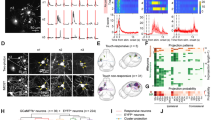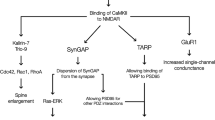Abstract
Dendritic spines are small membranous protrusions that receive synaptic inputs from other neurons, enabling the initiation of dendritic N-methyl-D-aspartic (NMDA) spikes and somatic action potentials. During learning and memory processes, both the number of spines on a dendrite and the morphology of individual spines are constantly changing. The individual influence of spine number and morphology on dendritic NMDA spikes has already been revealed, but the functional significance of the co-regulation of spine number and morphology on NMDA spikes remains elusive. Here, we systematically investigated the initiation of local dendritic NMDA spikes by the dynamic distributions of the spine number and morphology on single dendrites in reconstructed neuron models. Different from the traditional cognition, we found the threshold number of spines required to generate local dendrite NMDA spikes on distal dendrites is fewer than that on proximal ones, because the thinner distal dendrites own higher impedance. As for the spine morphology, the presence of more α-amino-3-hydroxy-5-methyl-4-isoxazole-propionic acid (AMPA) receptors on the spine leads to larger NMDA spikes rather than an increase in the spine dimension alone. Furthermore, we first suggested that a single dendrite containing spines with gradually increasing head diameters away from the soma could generate larger NMDA spikes than that irrational distribution of spine morphology containing spines with decreasing head diameters, which can be compensated by the increasing spine number. Complementarily, the distance-dependent distribution of spine number and morphology co-regulate the intension of dendritic NMDA spikes. These findings about the threshold for NMDA spikes provide novel insights into the role of the irrational dynamic distribution of the spine number and morphology in senescence and disease processes such as Alzheimer’s disease, schizophrenia, and Parkinson’s disease, which causes abnormal neuron firing.
Similar content being viewed by others
References
Cornejo V H, Ofer N, Yuste R. Voltage compartmentalization in dendritic spines in vivo. Science, 2022, 375: 82–86
Berry K P, Nedivi E. Spine dynamics: Are they all the same? Neuron, 2017, 96: 43–55
Walker C K, Herskowitz J H. Dendritic spines: Mediators of cognitive resilience in aging and Alzheimer’s disease. Neuroscientist, 2021, 27: 487–505
Parajuli L K, Koike M. Three-dimensional structure of dendritic spines revealed by volume electron microscopy techniques. Front Neuroanat, 2021, 15: 39
Knafo S, Alonso-Nanclares L, Gonzalez-Soriano J, et al. Widespread changes in dendritic spines in a model of Alzheimer’s disease. Cerebral Cortex, 2009, 19: 586–592
Roy D S, Arons A, Mitchell T I, et al. Memory retrieval by activating engram cells in mouse models of early Alzheimer’s disease. Nature, 2016, 531: 508–512
Ofer N, Berger D R, Kasthuri N, et al. Ultrastructural analysis of dendritic spine necks reveals a continuum of spine morphologies. Dev Neurobiol, 2021, 81: 746–757
Alimohamadi H, Bell M K, Halpain S, et al. Mechanical principles governing the shapes of dendritic spines. Front Physiol, 2021, 12: 836
Nicholson D A, Geinisman Y. Axospinous synaptic subtype-specific differences in structure, size, ionotropic receptor expression, and connectivity in apical dendritic regions of rat hippocampal CA1 pyramidal neurons. J Comp Neurol, 2009, 512: 399–418
Parker E M, Kindja N L, Cheetham C E J, et al. Sex differences in dendritic spine density and morphology in auditory and visual cortices in adolescence and adulthood. Sci Rep, 2020, 10: 9442
Bhatt D H, Zhang S, Gan W B. Dendritic spine dynamics. Annu Rev Physiol, 2009, 71: 261–282
Zhao W X, Zou W. Intrinsic and extrinsic mechanisms regulating neuronal dendrite morphogenesis. J Zhejiang Univ (Med Sci), 2020, 49: 90–99
Forrest M P, Parnell E, Penzes P. Dendritic structural plasticity and neuropsychiatric disease. Nat Rev Neurosci, 2018, 19: 215–234
Bosch M, Castro J, Saneyoshi T, et al. Structural and molecular remodeling of dendritic spine substructures during long-term potentiation. Neuron, 2014, 82: 444–459
Bourne J, Harris K M. Do thin spines learn to be mushroom spines that remember? Curr Opin Neurobiol, 2007, 17: 381–386
Mahmmoud R R, Sase S, Aher Y D, et al. Spatial and working memory is linked to spine density and mushroom spines. PLoS ONE, 2015, 10: e0139739
Kaufmann W E, Moser H W. Dendritic anomalies in disorders associated with mental retardation. Cerebral Cortex, 2000, 10: 981–991
Purpura D P. Dendritic spine “dysgenesis” and mental retardation. Science, 1974, 186: 1126–1128
Stephens B, Mueller A J, Shering A F, et al. Evidence of a breakdown of corticostriatal connections in Parkinson’s disease. Neuroscience, 2005, 132: 741–754
Chapleau C A, Calfa G D, Lane M C, et al. Dendritic spine pathologies in hippocampal pyramidal neurons from Rett syndrome brain and after expression of Rett-associated MECP2 mutations. Neurobiol Dis, 2009, 35: 219–233
Elston G N, Benavides-Piccione R, DeFelipe J. The pyramidal cell in cognition: A comparative study in human and monkey. J Neurosci, 2001, 21: RC163
Benavides-Piccione R, Fernaud-Espinosa I, Robles V, et al. Age-based comparison of human dendritic spine structure using complete three-dimensional reconstructions. Cerebral Cortex, 2013, 23: 1798–1810
Megıas M, Emri Z, Freund T F, et al. Total number and distribution of inhibitory and excitatory synapses on hippocampal CA1 pyramidal cells. Neuroscience, 2001, 102: 527–540
Konur S, Rabinowitz D, Fenstermaker V L, et al. Systematic regulation of spine sizes and densities in pyramidal neurons. J Neurobiol, 2003, 56: 95–112
Carnevale N T, Hines M L. The Neuron Book. Cambridge: Cambridge University Press, 2006
Basak R, Narayanan R. Active dendrites regulate the spatiotemporal spread of signaling microdomains. PLoS Comput Biol, 2018, 14: e1006485
Lombardi A, Jedlicka P, Luhmann H J, et al. Coincident glutamatergic depolarizations enhance GABAA receptor-dependent Cl− influx in mature and suppress Cl− efflux in immature neurons. PLoS Comput Biol, 2021, 17: e1008573
Li C, Gulledge A T. NMDA receptors enhance the fidelity of synaptic integration. eNeuro, 2021, 8: ENEURO.0396–20.2020
Zang Y, De Schutter E. The cellular electrophysiological properties underlying multiplexed coding in Purkinje cells. J Neurosci, 2021, 41: 1850–1863
Budak M, Grosh K, Sasmal A, et al. Contrasting mechanisms for hidden hearing loss: Synaptopathy vs myelin defects. PLoS Comput Biol, 2021, 17: e1008499
Bandera A, Fernández-García S, Gómez-Mármol M, et al. A multiple timescale network model of intracellular calcium concentrations in coupled neurons: Insights from rom simulations. Math Model Nat Pheno, 2022, 17: 11
Eyal G, Verhoog M B, Testa-Silva G, et al. Human cortical pyramidal neurons: From spines to spikes via models. Front Cell Neurosci, 2018, 12: 181
Tønnesen J, Katona G, Rózsa B, et al. Spine neck plasticity regulates compartmentalization of synapses. Nat Neurosci, 2014, 17: 678–685
Araya R, Vogels T P, Yuste R. Activity-dependent dendritic spine neck changes are correlated with synaptic strength. Proc Natl Acad Sci USA, 2014, 111: E2895–E2904
Coskren P J, Luebke J I, Kabaso D, et al. Functional consequences of age-related morphologic changes to pyramidal neurons of the rhesus monkey prefrontal cortex. J Comput Neurosci, 2015, 38: 263–283
Gidon A, Zolnik T A, Fidzinski P, et al. Dendritic action potentials and computation in human layer 2/3 cortical neurons. Science, 2020, 367: 83–87
Eyal G, Verhoog M B, Testa-Silva G, et al. Unique membrane properties and enhanced signal processing in human neocortical neurons. eLife, 2016, 5: e16553
Traub R D, Wong R K, Miles R, et al. A model of a CA3 hippocampal pyramidal neuron incorporating voltage-clamp data on intrinsic conductances. J Neurophysiol, 1991, 66: 635–650
Jahr C E, Stevens C F. Voltage dependence of NMDA-activated macroscopic conductances predicted by single-channel kinetics. J Neurosci, 1990, 10: 3178–3182
Rhodes P. The properties and implications of NMDA spikes in neocortical pyramidal cells. J Neurosci, 2006, 26: 6704–6715
Sarid L, Bruno R, Sakmann B, et al. Modeling a layer 4-to-layer 2/3 module of a single column in rat neocortex: Interweaving in vitro and in vivo experimental observations. Proc Natl Acad Sci USA, 2007, 104: 16353–16358
Matsuzaki M, Ellis-Davies G C R, Nemoto T, et al. Dendritic spine geometry is critical for AMPA receptor expression in hippocampal CA1 pyramidal neurons. Nat Neurosci, 2001, 4: 1086–1092
Shimizu E, Tang Y P, Rampon C, et al. Nmda receptor-dependent synaptic reinforcement as a crucial process for memory consolidation. Science, 2000, 290: 1170–1174
Pallas-Bazarra N, Kastanauskaite A, Avila J, et al. Gsk-3β overexpression alters the dendritic spines of developmentally generated granule neurons in the mouse hippocampal dentate gyrus. Front Neuroanat, 2017, 11: 18
Poleg-Polsky A. Effects of neural morphology and input distribution on synaptic processing by global and focal nmda-spikes. PLoS ONE, 2015, 10: e0140254
Rall W, Rinzel J. Branch input resistance and steady attenuation for input to one branch of a dendritic neuron model. Biophysl J, 1973, 13: 648–688
Nimchinsky E A, Yasuda R, Oertner T G, et al. The number of glutamate receptors opened by synaptic stimulation in single hippocampal spines. J Neurosci, 2004, 24: 2054–2064
Popovic M A, Gao X, Carnevale N T, et al. Cortical dendritic spine heads are not electrically isolated by the spine neck from membrane potential signals in parent dendrites. Cerebral Cortex, 2014, 24: 385–395
Irwin S A, Patel B, Idupulapati M, et al. Abnormal dendritic spine characteristics in the temporal and visual cortices of patients with fragile-X syndrome: A quantitative examination. Am J Med Genet, 2001, 98: 161–167
Jones E G, Powell T P S. Morphological variations in the dendritic spines of the neocortex. J Cell Sci, 1969, 5: 509–529
Sabatini B L, Svoboda K. Analysis of calcium channels in single spines using optical fluctuation analysis. Nature, 2000, 408: 589–593
Author information
Authors and Affiliations
Corresponding authors
Additional information
This work was supported by the National Key Research and Development Program of China (Grant No. 2019YFA0705400), the Natural Science Foundation of Jiangsu Province (Grant No. BK20212008), the National Natural Science Foundation of China (Grant No. 12002158), the Research Fund of State Key Laboratory of Mechanics and Control of Mechanical Structures (Grant Nos. MCMS-I-0421K01, MCMS-I-0422K01), the Fundamental Research Funds for the Central Universities (Grant No. NJ2022002), A Project Funded by the Priority Academic Program Development of Jiangsu Higher Education Institutions.
Supporting Information
The supporting information is available online at https://tech.scichina.com and https://link.springer.com. The supporting materials are published as submitted, without typesetting or editing. The responsibility for scientific accuracy and content remains entirely with the authors.
Supplementary Material
11431_2022_2165_MOESM1_ESM.pdf
Initiation of dendritic NMDA spikes co-regulated via distance-dependent and dynamic distribution of the spine number and morphology in neuron dendrites
Rights and permissions
About this article
Cite this article
Cao, Y., Shen, C., Qiu, H. et al. Initiation of dendritic NMDA spikes co-regulated via distance-dependent and dynamic distribution of the spine number and morphology in neuron dendrites. Sci. China Technol. Sci. 66, 429–438 (2023). https://doi.org/10.1007/s11431-022-2165-3
Received:
Accepted:
Published:
Issue Date:
DOI: https://doi.org/10.1007/s11431-022-2165-3




